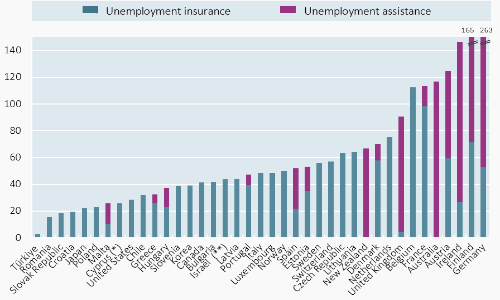Social and welfare issues
Social Benefit Recipients (SOCR) annual data by country
The Social benefits Recipients database, covering the main income replacement benefits in 41 EU and OECD countries provides a unique source of comparable information on the number of individuals receiving income replacement benefits across countries. SOCR data can be used to monitor programme participation and coverage rates, and provides contextual information for interpreting spending statistics and indicators of work incentives and benefit adequacy. It also sheds light on the dynamics of social benefit receipt in the context of the economic crisis in recent years. It currently covers twelve years (2007-2018) for most OECD and EU countries.
> Trend of recipients number by social protection branch> Pseudo-coverage rates of unemployment benefits |
> Programme-level data by country> Methodological notes |
Trend of recipients number by social protection branch |
[Download trend data (.xlsx)]
Programme-level data by country |
This release includes the number of recipients (usually annual averages) of the main income replacement programmes from 2007 to 2018. There are two ways to access the data :
• SOCR database accessible via OECD.stat : Information on the comprehensive list of SOCR programmes, including annual recipient stocks by sex and age group, annual inflows and relevant reference series
• Country note and metadata : SOCR country-specific files below containing annual recipient stocks of selected programmes [xlsx] and metadata containing qualitative information about benefits and the units in which recipients stocks are expressed [pdf].
|
›› Australia ›› Denmark ›› Hungary ›› Korea ›› Norway ›› Sweden |
›› Austria ›› Estonia ›› Iceland ›› Latvia ›› Poland ›› Switzerland |
›› Belgium ›› Finland ›› Ireland ›› Lithuania ›› Portugal ›› Türkiye |
›› Canada ›› France ›› Israel * ›› Luxembourg ›› New Zealand ›› Spain |
›› Chile ›› Germany ›› Italy ›› Mexico ›› Slovak Republic ›› United Kingdom |
›› Czech Republic ›› Greece ›› Japan ›› Netherlands ›› Slovenia ›› United States |
||||||
|
Non-OECD EU countries and territories |
|||||||||||
|
›› Bulgaria |
›› Cyprus ** |
›› Croatia |
›› Malta |
›› Romania |
|
||||||
Pseudo-coverage rates of unemployment benefits |
 |
Pseudo-coverage is the total number of recipients of a given programme or group of programmes relative to the number of individuals in some group of interest, which usually is the one a priori targeted by the programme(s).In the chart, the numerator is the number of beneficiaries of earnings-related unemployment benefits (unemployment insurance) and of non-contributory benefits (unemployment assistance) for jobseekers who have exhausted their insurance benefit or were not entitled to it.The denominator is the number of unemployed individuals (over 15 years old) according to the ILO definition. It is important to note that these coverage rates are not shares since the numerator and the denominator may only partially overlap; for this reason, measured pseudo-coverage rates can exceed 100%.Readers are strongly encouraged to carefully read the methodological notes provided along with coverage figures in the excel file. |
Methodological notes |
The SOCR database relies on administrative data provided by governments and has been compiled as part of an ambitious joint project initiated by OECD and the European Commission in 2010. Along with existing information on social spending (SOCX) and on the adequacy of benefit levels (TaxBEN), the SOCR data shed light on the effectiveness and efficiency of social protection policies.
• SOCR definitions and methodology
Notes
These documents were produced with the financial assistance of the European Union Programme for Employment and Social Innovation “EaSI” (2014-2020). The opinions expressed and arguments employed herein do not necessarily reflect the official views of the OECD member countries or of the European Union.
* The statistical data for Israel are supplied by and under the responsibility of the relevant Israeli authorities. The use of such data by the OECD is without prejudice to the status of the Golan Heights, East Jerusalem and Israeli settlements in the West Bank under the terms of international law.
**Footnote by Türkiye: The information in this document with reference to « Cyprus » relates to the southern part of the Island. There is no single authority representing both Turkish and Greek Cypriot people on the Island. Türkiye recognizes the Turkish Republic of Northern Cyprus (TRNC). Until a lasting and equitable solution is found within the context of the United Nations, Türkiye shall preserve its position concerning the “Cyprus issue”.
**Footnote by all the European Union Member States of the OECD and the European Union: The Republic of Cyprus is recognized by all members of the United Nations with the exception of Türkiye. The information in this document relates to the area under the effective control of the Government of the Republic of Cyprus.
Related Documents